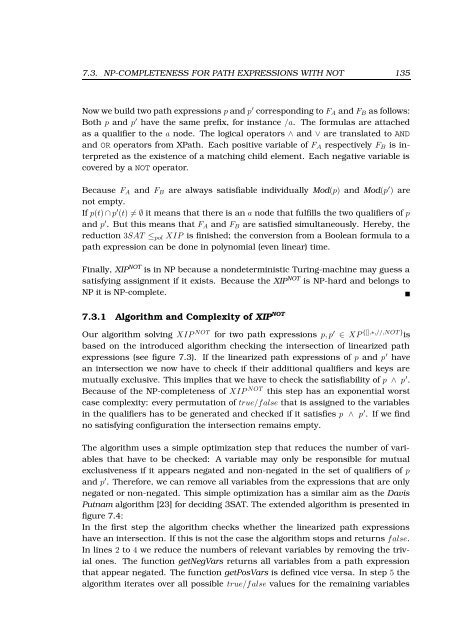url - Universität zu Lübeck
url - Universität zu Lübeck
url - Universität zu Lübeck
Create successful ePaper yourself
Turn your PDF publications into a flip-book with our unique Google optimized e-Paper software.
7.3. NP-COMPLETENESS FOR PATH EXPRESSIONS WITH NOT 135<br />
Now we build two path expressions p and p ′ corresponding to F A and F B as follows:<br />
Both p and p ′ have the same prefix, for instance /a. The formulas are attached<br />
as a qualifier to the a node. The logical operators ∧ and ∨ are translated to AND<br />
and OR operators from XPath. Each positive variable of F A respectively F B is interpreted<br />
as the existence of a matching child element. Each negative variable is<br />
covered by a NOT operator.<br />
Because F A and F B are always satisfiable individually Mod(p) and Mod(p ′ ) are<br />
not empty.<br />
If p(t) ∩ p ′ (t) ≠ ∅ it means that there is an a node that fulfills the two qualifiers of p<br />
and p ′ . But this means that F A and F B are satisfied simultaneously. Hereby, the<br />
reduction 3SAT ≤ pol XIP is finished; the conversion from a Boolean formula to a<br />
path expression can be done in polynomial (even linear) time.<br />
Finally, XIP NOT is in NP because a nondeterministic Turing-machine may guess a<br />
satisfying assignment if it exists. Because the XIP NOT is NP-hard and belongs to<br />
NP it is NP-complete.<br />
<br />
7.3.1 Algorithm and Complexity of XIP NOT<br />
Our algorithm solving XIP NOT for two path expressions p, p ′ ∈ XP {[],∗,//,NOT } is<br />
based on the introduced algorithm checking the intersection of linearized path<br />
expressions (see figure 7.3). If the linearized path expressions of p and p ′ have<br />
an intersection we now have to check if their additional qualifiers and keys are<br />
mutually exclusive. This implies that we have to check the satisfiability of p ∧ p ′ .<br />
Because of the NP-completeness of XIP NOT this step has an exponential worst<br />
case complexity: every permutation of true/false that is assigned to the variables<br />
in the qualifiers has to be generated and checked if it satisfies p ∧ p ′ . If we find<br />
no satisfying configuration the intersection remains empty.<br />
The algorithm uses a simple optimization step that reduces the number of variables<br />
that have to be checked: A variable may only be responsible for mutual<br />
exclusiveness if it appears negated and non-negated in the set of qualifiers of p<br />
and p ′ . Therefore, we can remove all variables from the expressions that are only<br />
negated or non-negated. This simple optimization has a similar aim as the Davis<br />
Putnam algorithm [23] for deciding 3SAT. The extended algorithm is presented in<br />
figure 7.4:<br />
In the first step the algorithm checks whether the linearized path expressions<br />
have an intersection. If this is not the case the algorithm stops and returns false.<br />
In lines 2 to 4 we reduce the numbers of relevant variables by removing the trivial<br />
ones. The function getNegVars returns all variables from a path expression<br />
that appear negated. The function getPosVars is defined vice versa. In step 5 the<br />
algorithm iterates over all possible true/false values for the remaining variables
















